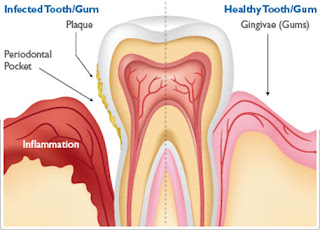In this four-part article series, a panel of dental implant surgeon provides us with an in-depth understanding of gum disease, which is one of the most common illnesses affecting American society today.
Welcome to the second installment of this four-part article series on gum disease and the considerable problems it causes for those unfortunate Glendale residents who may have it. Previously, in Part 1 of the series, we took a look at the key symptoms of gum disease, the main ones being gum inflammation, swelling and bleeding and bad breath.
“Untreated gum disease will eventually lead to tooth loss,” warned our panel of dental implant surgeons in Glendale.
In Part 2, we’ll be shifting our attention to the very habits and lifestyles that leave us far more susceptible to developing gum disease. But first…
What Exactly IS Gum Disease?

Gum disease is a condition resulting from a chronic bacterial infection of the gums. It begins as a mild infection called “gingivitis,” which typically presents as slightly puffy and inflamed gums, as well as bad breath. With persistent bad habits, such as smoking, a poor diet, heavy alcohol consumption and/or poor oral hygiene, the infection can become more severe.
“Oral bacteria consume the sugars we introduce to our mouths and produce acidic by-products that erode away our dental enamel and irritate the gums,” explains a Glendale dental implant surgeon. “This is how cavities and gum inflammation are caused and it’s precisely why regular brushing and flossing are so important.
“However, as the infection is allowed to progress, the bacteria can penetrate into the snug spaces between the teeth and the gums, where no amount of brushing can eliminate them. Here, they form deep periodontal pockets of infection that can ultimately destroy the ligaments and other connective tissues that keep the teeth in place, which is why untreated gum disease leads to tooth loss. It’s at this advanced stage that the disease becomes known as “periodontitis”.”
The Top Causes of Gum Disease
And so, to recap what was discussed in the previous section, gum disease is typically caused by one or more of the following factors:
• Poor oral hygiene: Not brushing or flossing thoroughly and/or frequently enough and not seeing the oral hygienist for a professional clean at least twice per year.
• Tobacco use: Chewing and smoking tobacco irritate the gums and encourage the growth of bacteria that lead to gum disease.
• A bad diet high in sugar: Oral bacteria are fuelled by sugar, so if you have a diet that is packed with sugar and simple carbohydrates, you will be at a greater risk of tooth decay and gum disease.
• Genetics: “Unfortunately this is not something you can do much about,” say Glendale dental implant surgeons. “If you are genetically predisposed to having gum problems and/or if you are male, you will have to up your oral hygiene routine and be stricter on your diet in order to prevent yourself from developing gum disease.”
• Alcohol consumption: Alcoholic beverages tend to be acidic and packed with sugar, which is bad enough for your teeth. Couple that with the dehydrating effects of alcohol and the unhealthy eating that tends to come hand-in-hand with a heavy night out and you’ve got a recipe for gum disease. Moderate your intake.
• Certain medications: If you’re on chronic medications for depression, heart disease or allergies and if you’ve noticed that these medications tend to give you “dry mouth,” speak to your dentist about it. Saliva is important in fighting the bad bacteria in the mouth and so a deficit of it can leave you more vulnerable to gum disease.
• Hormonal fluctuations: “During puberty, menopause and pregnancy, your hormones tend to be all over the place and this can leave you more susceptible to gum problems,” explains one dental implant surgeon in Glendale. “Make sure you visit your dentist regularly during these times and keep up the healthy eating and good home oral hygiene!”
Stay Tuned for Part 3
To find out more about gum disease and why it poses such a health risk to Glendale residents, stay tuned for the third installment of this four-part article series.
No comments:
Post a Comment